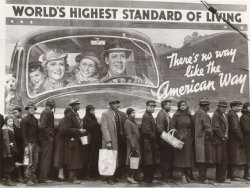Lessons from History - Part 1: Economic Depression in 1930s America

It's interesting to compare the current economic slump to what was written about the 1930s'. There are a number of common elements, but many of the locations, players and types of debt and speculation have changed somewhat.
Extract from Mastering Modern World History, Second Edition, by Norman Lowe, published by Macmillan - pages 111 to 113. The numbering and use of bold and italic type are from the original text.
(a) What caused the great depression?
(i) American industrialists, encouraged by high profits and aided by increased mechanisation, were producing too many goods for the home market to absorb. (in the same way as American farmers). This was not apparent in the early 1920s, but as the 1930s approached unsold stocks of goods began to build up, and manufacturers produced less; since fewer workers were required, men were laid off; and as there was no unemployment benefit, these men and their families bought less. And so the vicious circle continued.
(ii) There was a maldistribution of income, which means that the enormous profits made by industrialists were not being shared evenly among the workers. The average wage for industrial workers rose by about 8 per cent between 1923 and 1929 but during the same period industrial profits increased by 72 per cent. An 8 per cent increase in wages meant that there was not enough buying power in the hands of the general public to sustain the boom: they could manage to absorb production for a time with the help of credit but by 1929 they were fast approaching the limit. Unfortunately manufacturers, usually in the form of the super-corporation, were not prepared to reduce prices or to increase wages substantially, and so the glut of consumer goods built up. This refusal by the manufacturers to compromise was shortsighted to say the least; at the beginning of 1929 there were still millions of Americans who had no radio, no electric washer and no car because they could not afford them. If employers had been content with rather less profit there is no reason why the boom could not have continued for several more years while its benefits were more widely shared. Even so, a slump was still not inevitable provided the Americans could export their surplus products.
(iii) However, exports began to fall away, partly because foreign countries were reulctant to buy American goods when the USA herself put up tariff barriers to protect her industries from foreign imports. Thus it became clear that although the Fordney-McCumber tariff (1922) was helping to keep foreign goods out, at the same time it was preventing foreign states, especially those in Europe, from making much-needed profits from trade with the USA. Without those profits European states would be able neither to buy American goods nor to pay in full their war debts to the USA. To make matters worse many states retaliated by introducing tariffs against American goods. A slump of some sort was clearly on the way.
(iv) The situation was worsened by the great rush of speculation on the stock market which begain to gather momentum about 1926. 'Speculation' is the buying of shares in companies; people with cash to spare like to do this with two possible aims in mind - to get the dividend (the annual sharing out of the company's profits, assuming that it has made any) or to make a quick profit by selling the shares again for more than they have paid for them. In the mid-1920s the second aim most attracted investors: as profits of companies increased, more people began to buy shares, thus rapidly forcing up share prices and offering plenty of chances for a quick profit from buying and selling shares. The average value of a share rose from 9 dollars in 1924 to 26 dollars in 1929; share prices of individual companies often rose spectacularly: for example the stock of the Radio Corporation of America stood at 85 dollars a share in 1928 and had risen to 505 dollars in September 1929, and that was a company which did not pay dividends.
Promise of quick profits encouraged all sorts of rash moves: quite poor people spent their savings or borrowed money to buy a few shares; stockbrokers sold shares on credit; banks speculated in shares using the cash deposited with them. It was all something of a gamble but there was enormous confidence that prosperity would continue indefinitely. This confidence lasted well into 1929, but when the first signs appeared that sales of goods were beginning to slow down, better informed investors decided to sell their shares while prices were still high. This caused suspicion to spread - more people than usual were trying to sell shares - something must be wrong! Confidence in the future began to waver for the first time and more people decided to sell their shares while the going was good. And so a process of what economists call self-fulfilling expectations developed. This means that by their own actions investors actually caused the dramatic collapse of share prices which they were afraid of. By October 1929 there were a flood of people rushing to sell shares, but because confidence had been shaken, far fewer people wanted to buy; share prices tumbled and unfortunate investors had to accept whatever they could get; one particularly bad day was 24 October - Black Thursday - when nearly 13 million shares were 'dumped' on the stock market at depressingly low prices. By mid-1930 share prices were down to about 25 per cent of the peak level; and even after that they continued to fall, reaching rock bottom in 1932. By then the whole of the USA was in the grip of depression.
Edited 12.11.11: Typo.
Edited 18.1.14: Typos.
Image credit.



